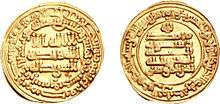Al-Mu'tazz
| Al-Mu'tazz المعتز | |
|---|---|
 Gold dinar of al-Mu'tazz, AH 253 (867 AD) | |
| 13th Caliph of the Abbasid Caliphate | |
| Reign | 17 October 866 —9 July 869 |
| Predecessor | al-Musta'in |
| Successor | al-Muhtadi |
| Born | 847 |
| Died | July/August 869 (aged 22) |
| Consort | Fatimah Khatun bint al-Fath ibn Khaqan |
| Dynasty | Abbasid |
| Father | al-Mutawakkil |
| Religion | Islam |

Al-Mu'tazz (847 – July/August 869) (Arabic: المعتز) was the title of the Abbasid Caliph in Baghdad from 866 to 869, during the "Anarchy at Samarra". Placed upon the throne by the Turks, he proved but too apt a pupil of his Turkish masters. He became the caliph at 19 he was the youngest Abbasaid Caliph to assume power.[1] He was surrounded by parties each jealous of the other. At Samarra, the Turks were having problems with the "Westerners" (Berbers and Moors); while the Arabs and Persians at Baghdad, who had supported al-Musta'in, regarded both with equal hatred. Al-Mu'tazz was thus surrounded by people who were ready for plot or treachery whether against each other or against al-Mu'tazz:—a poor justification, however, for the course of betrayal and bloodshed which he, not less than they, pursued.
First he put to death the former Caliph al-Musta'in. Then his own brother Al-Mu'eiyyad, being next heir to the throne, was also cruelly put to death. Also another brother, Abu Ahmed, who had bravely led the troops in the late struggle on his side, was thrown into prison. The Turks attempted his release, but al-Mu'tazz, the more alarmed, resolved on his death. He was smothered in a downy robe (or, as others say, frozen in a bed of ice); and the body was then exposed before the Court, as if, being without mark of violence, he had died a natural death.
The revenues were squandered at the reckless Court, and little was left to pay the troops. The city guards at the Capital surrounded the palace at Baghdad, demanding for their pay. The Governor wrote to al-Mu'tazz for an advance; but he, prompted by the Turks, replied that "if the guards were needed for himself, he himself might pay them; if for the Caliph, he cared not for them." Thereupon the insurgency was renewed; the mob refused to let the Caliph be named in the Mosque, and so there were no prayers observed that Friday. Before the revolt was put down, the Governor had to burn one of the bridges, and set fire to an adjoining bazaar, in order to keep the rebels off. But the next year all joined together—Turks, Africans, and Persians—stormed the palace for their pay.
The army's pay having been withheld, Salih son of Wasif, one of the rebels, seized the personal secretaries of al-Mu'tazz and demanded the money embezzled or concealed by them. There being no answer but an empty treasury, they were put in irons. The Caliph implored the rebels to release his private secretary, but they were deaf to his plea. The accounts of the unfortunate ministers were seized, but nothing could be extracted from them.
Salih, and another rebel Musa, planned to depose al-Mu'tazz, and carried out the design with brutal inhumanity. Followed by a clamorous troop, they seated themselves at the palace gate, and called for the Caliph to come out. Not suspecting treachery, Caliph called them in. Entering, they beat him with clubs and kicked him; then dragging him by his torn robes outside; they left him seated there in the scorching heat of a mid summer sun. He was then shut up in a room alone without food or water; and so after three days the wretched Caliph died, at the early age of twenty-four.
References
- ↑ History of the Arabs by Philip K Hitti
- This text is adapted from William Muir's public domain, The Caliphate: Its Rise, Decline, and Fall.
| Al-Mu'tazz Born: ? Died: 869 | ||
| Sunni Islam titles | ||
|---|---|---|
| Preceded by Al-Musta'in |
Caliph of Islam Abbasid Caliph 866 – 869 |
Succeeded by Al-Muhtadi |